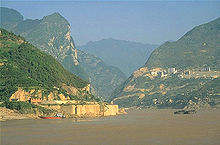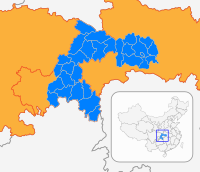Three Gorges
This article needs additional citations for verification. (February 2011) |
| Three Gorges | |||||||||||||||||||
|---|---|---|---|---|---|---|---|---|---|---|---|---|---|---|---|---|---|---|---|
 The Yangtze in the Three Gorges region. | |||||||||||||||||||
| Simplified Chinese | 三峡 | ||||||||||||||||||
| Traditional Chinese | 三峽 | ||||||||||||||||||
| |||||||||||||||||||


The Three Gorges (Chinese: 三峡; pinyin: ) are three adjacent gorges along the middle reaches of the Yangtze River in the People's Republic of China. The Three Gorges have long been renowned for their spectacular scenery, and the "Three Gorges Scenic Area" is classified as a AAAAA scenic area (the highest level) by the China National Tourism Administration.[1]
Overview
The Three Gorges span from the western—upriver cities of Fengjie and Yichang in Chongqing Municipality eastward—downstream to Hubei province The Three Gorges region attracts global attention due to the Three Gorges Dam, which is firmly changing the culture and environment of the river and Three Gorges region.[citation needed]
The Yangtze River (Chang Jiang)—Three Gorges region has a total length of approximately 200 kilometres (120 mi). The Three Gorges occupy approximately 120 kilometres (75 mi) within this region. Although it is primarily famous for its scenery, the Three Gorges region is also a historically and culturally important location in China. Many settlements and archeological sites are under submersion from the rising Three Gorges Dam.[citation needed]
The Three Gorges
| Gorge | Chinese | Length (km) | Range |
|---|---|---|---|
| Qutang Gorge | 瞿塘峡 | 8 | from Baidicheng (Fengjie) to Daxi |
| Wu Gorge | 巫峡 | 45 | from Wushan to Guandukou (Badong) |
| Xiling Gorge | 西陵峡 | 66 | from Zigui to Nanjin Pass (Yichang) |
Three Gorges Dam
The Three Gorges Dam was constructed at a place called Sāndòupíng in the middle of the Xiling Gorge. The reservoir dam was completed in the summer of 2006, and the water level quickly reached the maximum level of 110m above the downstream river. The project was completed by the end of 2008, although a ship lift is still in course of construction, and expected to be completed in 2015.[citation needed]
The dam and Three Gorges Reservoir has had a massive impact upon the region's ecology and people, involving the mass relocation of towns and villages.[citation needed] The higher water level has changed the scenery of the Three Gorges, so that the river is wider and the mountains appear lower. However, the mountains still tower above the river, and the gorges continue to offer spectacular views of the surrounding cliffs.
The riverboat companies that operate in the Three Gorges are experiencing a boom in demand for river cruises.[citation needed] The increased width and depth of the river permits larger ships through the gorges, and there has been a significant increase of river traffic of all kinds, including bulk cargo and container barges.

See also
- Baiheliang Underwater Museum
- Chinese yuan note — the westernmost gorge image is on the ten yuan note.
- Three Gorges Locks
- Three Gorges Museum
References
- ^ "AAAAA Scenic Areas". China National Tourism Administration. 16 November 2008. Retrieved 9 April 2011.



